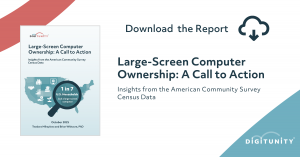Why technology donation must move from afterthought to strategy, and how to make it work across your IT lifecycle
Technology donation has historically been an afterthought for many companies, rather than an intentional part of asset management or refresh planning. Few organizations have developed the necessary systems to support it. Surplus equipment is increasingly difficult to find as refresh cycles lengthen and devices stay in use longer. Meanwhile, the systems that could streamline donation haven’t evolved alongside today’s business needs. Companies that overlook this gap face rising costs, increased complexity, and missed opportunities to extend the value of retired assets.
What looks stable today is poised to shift fast. Bulk purchases from 2020-2021 are now cycling out, driven by Microsoft’s Windows 10 end-of-support and rising performance demands from AI workloads. Yet this moment of availability is not a sustainable trend. Projections from IDC show a modest 4.3% rise in PC shipments in 2025, but the underlying dynamics tell a more complex story.

Key emerging trends are challenging traditional refresh assumptions:
- Higher-performance systems are being retained longer to support AI workloads.
- Supply chain uncertainties are making organizations hesitant to offload potentially valuable assets.
- Dual-device setups driven by hybrid work models
Inside the Shrinking Supply:
Devices with advanced specifications – discrete GPUs, expanded RAM, and embedded AI chipsets- are no longer seen as surplus. They are strategic assets retained for compute-heavy tasks. Organizations increasingly evaluate devices based on their ability to handle local AI processing. PCs will make up 20% of all PC shipments by the end of 2025, with Neural Processing Units (NPUs) becoming a standard hardware feature as manufacturers shift to more premium, AI-capable systems. This trend is expected to increase average selling prices and decrease surplus availability, as organizations retain these devices longer or redeploy them internally to future-proof their infrastructure.
This CRN report summarizes this shift, noting that prominent Original Equipment Manufacturers (OEMs) are strategically investing in fewer, more powerful device models. This approach focuses on high-performance refreshes for 2025, rather than volume-based device turnover.
At the same time, tariff volatility is reshaping how companies manage inventory. Enterprise notebooks, desktops, workstations, and accessories face a 10–12% tariff increase in early 2025. In response, many organizations pre-purchase and hold inventory longer to hedge against pricing fluctuations. These changes delay disposition and reduce the number of devices entering the donation pipeline.
Procurement teams adapt by holding onto assets previously slated for retirement, introducing delays in refresh cycles, and creating uncertainty around what devices, if any, will be released for community reuse.
Some innovative businesses are responding by partnering with certified recycling facilities or donating used devices to charities as part of their sustainability efforts. These approaches reflect a growing recognition that responsible end-of-life planning contributes directly to environmental goals and stakeholder expectations.
In parallel, millions of U.S. computers with residual value go unused or are mishandled, reinforcing the need for a systems-level solution that proactively integrates reuse, donation, and asset disposition into IT lifecycle planning.
Organizations are rethinking their IT disposition strategies to avoid budget shocks and equipment delays. Many are pre-buying inventory to hedge against rising costs, while holding onto devices that might soon become more expensive to replace, reducing the likelihood of donation.
Large consumer-facing retailers, like Costco, are taking defensive action by increasing inventory in anticipation of price volatility. Device resellers are following suit, extending delivery times as they wait for potential margin improvements. For enterprise IT teams, these trade-driven dynamics are not just procurement challenges but strategic hurdles in managing surplus and refresh cycles.
Risk, Responsibility, and Systems Alignment:
Donation decisions are often paused by legitimate concerns about compliance and brand protection. IT leaders regularly weigh questions around secure data handling, the credibility of recipients, and exposure to reputational or legal risk.
Without trusted processes in place, donation can seem unpredictable or risky. That perception is often the result of fragmented systems rather than actual risk.
Digitunity works with certified ITAD partners, applies rigorous vetting to nonprofit recipients, and offers secure, auditable workflows. These systems support data privacy, policy alignment, and ESG reporting standards.
Adding to the challenge, large businesses are often excluded from end-of-life product recycling programs, meaning significant volumes of retired devices never reach reuse or donation channels. The absence of federal legislation has led to a patchwork of state-level policies, creating uncertainty and limiting businesses’ ability to manage IT asset recovery at scale. Organizations are expected to demonstrate their own environmental stewardship and responsible technology management.
Why Donation Isn’t the Default:
Most companies follow standard IT asset disposition (ITAD) workflows that lead to resale, lease return, or recycling. Donation is rarely built into early-stage planning or budgeting. Procurement teams face limited options for secure handoff and often lack donation-ready processes.
On the recipient side, requests come in sporadically and vary in quality. This results in inconsistent vetting, limited device readiness, and missed timing. Without a centralized system, many organizations reach out to companies individually, resulting in inconsistent requests and added administrative burden for already-stretched IT departments. The absence of coordination creates gaps in vetting, device readiness, and usability for end recipients, undermining the very impact both sides hope to achieve.
The result is a fractured, high-friction ecosystem.
The Value of a Structured Approach:
Donation supports multiple operational and workforce goals when aligned with lifecycle management. Organizations that treat donation as a structured process see:
- Reduced storage and recycling costs
- Faster retirement of legacy systems
- Stronger ESG alignment
- Increased employee engagement
According to Deloitte, 77% of millennials and Gen Z workers consider a company’s social impact when making career decisions. Technology donation demonstrates purpose in a visible and practical way.
Digitunity collaborates with companies to embed donation into existing IT lifecycle workflows. Not by creating new workstreams, but by making existing ones more effective.
Our Model Includes:
- Secure, certified ITAD partnerships
- Corporate concierge donation services with streamlined matching with qualified nonprofit recipients
- Transparent systems that integrate with ESG and IT compliance needs
Technology donations don’t usually require subscriptions, fees, or service charges. Digitunity provides these services at low or no cost to our partners. Our involvement simplifies logistics and planning, making donations easier to manage and scale. Companies gain direct support without adding unnecessary complexity to their internal processes.
Digitunity is helping to reshape how technology donations work across the field. Our focus is on infrastructure and systems that enable strategic giving to function seamlessly within existing business operations, not as an add-on, but as an integral part of the core.
Practical Next Steps:
You don’t need a complete overhaul to make donation part of your IT strategy. Here are steps to start aligning internal operations with long-term impact:
- Designate 10% of retiring devices for donation
- Incorporate donation into ESG and CSR policies
- Create pre-approved donation pathways with internal teams
- Partner with a trusted facilitator like Digitunity
When donation is structured, secure, and aligned with your brand values, it becomes a strategic advantage, not a logistical burden.
To see how Digitunity’s Corporate Concierge Donation Services can support your company’s next refresh or disposition cycle, visit our corporate donation page to learn more.
*This article was originally published in PC World.
Digitunity is a national nonprofit organization with a mission to make owning a computer possible for everyone. Engaged in advancing digital opportunity for nearly forty years, Digitunity generates and places donated computers with organizations serving people in need, supports a national practitioner network, and advises states, cities, and coalitions on strategies to meet the ongoing device needs of people impacted by the digital divide.


